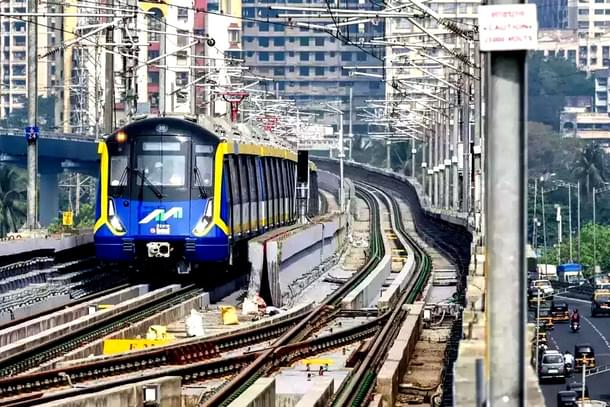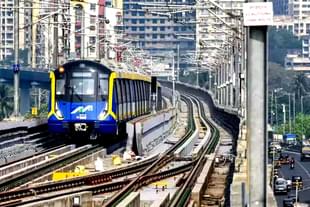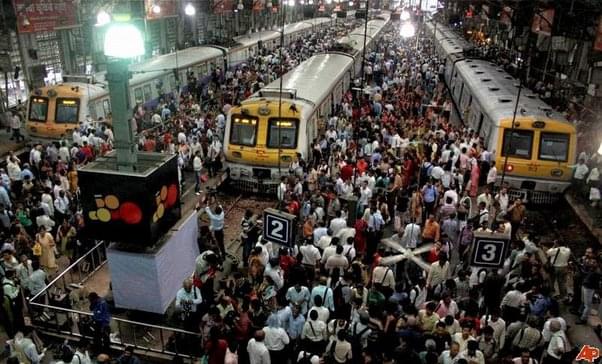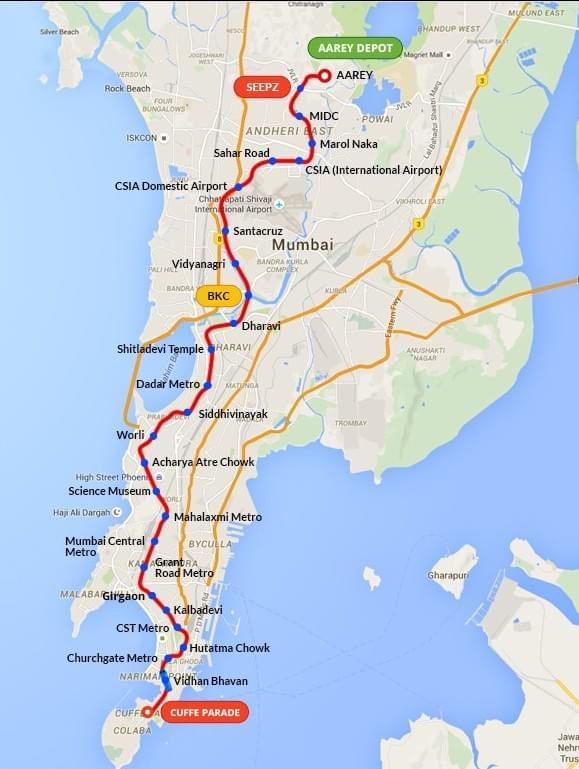Infrastructure
Mumbai's Metro 3 Arrives: Mumbaikars Are Finally Getting The Long-Awaited Relief From The Struggles Of Local Trains
Ankit Saxena
Aug 18, 2024, 11:29 AM | Updated Sep 05, 2024, 11:30 AM IST
Save & read from anywhere!
Bookmark stories for easy access on any device or the Swarajya app.


The Mumbai Metro 3 project is nearing completion, with 97 per cent of the work on its first phase — connecting SEEPZ to the Bandra-Kurla Complex (BKC) — and is expected to become operational within the next few months.
This eagerly awaited underground metro line, known as the 'Aqua Line', is part of a 14-line network for the city and will be the only one connecting the southernmost parts of Mumbai.
It will link the Cuffe Parade business district in the extreme south to SEEPZ in the north-central area, extending further to the northern suburbs, earning it the moniker of ‘connecting the unconnected’.
As India's financial capital, Mumbai has long been notorious for its transportation woes. However, the new phase of transit connectivity, including Metro Line 3, is envisioned to address these long-standing issues.
How Mumbai Travels Currently
For years, Mumbai's fast-paced lifestyle has relied heavily on the Mumbai local trains as the primary mode of transport. This 400 km rail system handles about 8 million daily commuters, often exceeding its capacity by more than four times during peak hours.
Over the years, the city's expansion and cultures have been closely tied to this local train network.
However, from becoming the defining aspect of life in Mumbai, it has become increasingly overburdened with the growing population and rising demand, while the infrastructure development to support it did not keep pace.
The heavy dependence on local trains has turned commuting into a skill, requiring the ability to navigate through crowded conditions and time journeys accurately. In recent decades, the Mumbai local system has faced numerous challenges, including overcrowding and frequent mishaps.
In June 2024, the Central and Western Railways faced criticism due to the alarming number of commuter deaths on Mumbai’s local trains. According to a PIL filed in the Bombay High Court, 2,590 commuters lost their lives on the Mumbai suburban rail in 2023, averaging about seven fatalities per day.
Each day, commuters struggle to squeeze into overcrowded trains, with some even hanging onto the edges during their journey.
As the city expanded and people moved to newer areas, the local train network failed to keep up, forcing many to travel for hours. Some start as early as 5 am to reach the main city and repeat the gruelling journey in the evening.
This includes, children, the young workforce and even women, who spend hours long journeys each day, facing risks, discomforts, and the added challenges of theft and crime.
For many, commuting on this network to cover long distances has defined their entire lives, and schedules of families in Mumbai to be arranged and surrounded by these networks.

A Much-Needed Transition for Mumbai’s New Workforce
While older generations have adapted to Mumbai's traditional commuting culture centred around the local trains, the newer generations are increasingly dissatisfied with this outdated system.
With Mumbai's rapid growth, the expansion of commercial areas like BKC, and the continuous sprawl of the Mumbai Metropolitan Region (MMR), many believe the city's mass transit system is overdue for an upgrade.
Given Mumbai's linear geography, the majority of transit movements occur along the north-south axis.
Metro Line 3, is planned with the same alignment, and will be the only line extending to the extreme south, connecting Colaba to the northern economic hub of SEEPZ via Bandra, linking several key stations along the way.
Among the broader transit benefits that the new line aims to offer, a key goal is to reduce the burden and challenges associated with commuting on Mumbai's local trains.

Inderjeet, a young Mumbai resident, is eagerly awaiting the new metro line's operation as he is tired of the challenges of commuting on the local trains.
As a field worker, he frequently travels across the length and breadth of the city and finds the local train system increasingly difficult to navigate.
“Although the local trains are reliable, our work patterns, weather conditions, and the city itself have changed over time. This also calls for a change in our commuting experience.” he tells Swarajya.
He adds, "The city has grown at an unmatched pace. Traveling on the local trains, with their limited air-conditioned compartments, only adds to the stress of our fast-paced work lives, as we continue to deal with tense situations, potential theft, and overcrowding."
However, many longtime local train travellers, also expressed concerns, with the dying culture of the local train due to the metro introduction, and chose to stick to the same transit options.
Yet, they acknowledge that the new metro line offers significant advantages, better suited to today's needs, and believe it will help distribute passenger numbers for more convenient travel.
The local travellers, now believe that the new metro system will foster a better, safer commuting culture, with improved infrastructure, amenities, and reliability.
As the city evolves and the surrounding infrastructure transforms, the citizens look forward to the need for a modern transit system that mirrors those found in other major cities across India and abroad — but had been long missing in the financial capital of the country.
Expectations From The New Line
The new metro line, will reduce the pressure on the local trains, connect areas that were previously inaccessible by rail, and provide the much-needed advanced transit experience.
This transition is expected to encourage more people to shift from cars to the metro, thanks to its improved connectivity.
According to government data, in its initial phase, this metro line will draw over 15 per cent of its passengers from local train commuters, while also adding people shifting from road travel.
Currently, a large number of people commute daily to SEEPZ and MIDC, typically taking the local train to Andheri before transferring to buses or shared autos to reach their workplaces.
The queues for buses outside Andheri station are a common sight. With no direct connection to SEEPZ and MIDC, the new metro line is a welcome relief.
The new metro network will connect areas currently served by the overcrowded stations on Mumbai’s Western Line, such as CSMT, Dadar, and Churchgate, while also expanding options for the southernmost parts of the city, which currently rely heavily on the single station at Churchgate.





